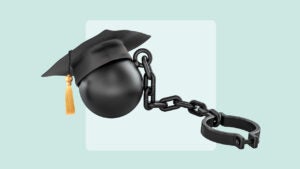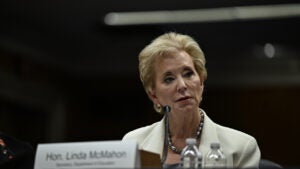Survey: The presidential election looming, 29% of borrowers say student loan debt will have a major influence on their vote

Only a small share of adults have student loan debt, but President Joe Biden and former President Donald Trump may still have to make it a key part of their platform while campaigning for the White House, a new Bankrate survey indicates.
Nearly 1 in 5 adults (18 percent) say student loan debt will have a major influence over their vote in the upcoming 2024 presidential election, according to Bankrate’s Student Loans and the Presidential Election Survey. Meanwhile, more than 1 in 4 Americans call student loan debt a national crisis (29 percent) and say the federal government hasn’t done enough to provide borrowers with financial assistance (27 percent).
That’s even as just 17 percent of adults carry federal debt, Census Bureau and Federal Student Aid data shows. The findings suggest that concerns of college affordability and rising educational debt — now reaching $1.6 trillion — aren’t limited to individuals personally carrying the burden.
Yet, student loan borrowers care even more. The share of Americans calling student loan debt a national crisis rises to 46 percent among those who have debt for themselves. About 3 in 10 of those who have debt for themselves or someone else (29 percent) say it will be a key factor in their vote.
Both Trump and Biden have attempted to appeal to borrowers with debt during their stints in the Oval Office. Trump was the first to institute a more than three-year-long coronavirus pandemic-era forbearance program that put both payments and interest on pause. Biden, on the other hand, created a new income-driven repayment plan that’s speeding up forgiveness and reducing monthly costs for millions of borrowers. Despite the Supreme Court rebuffing his sweeping forgiveness program in 2023, he’s canceled $167 billion in loans — or roughly 10 percent of all federal debt — for nearly 5 million borrowers and is moving forward with a “Plan B” program to help even more.
Borrowers in Bankrate polls dating back almost a decade indicate that their debt is casting a dark shadow over their financial lives, impacting their ability to achieve the same financial milestones as generations before them. But for the Americans saddled with debt to pay for their own education, student loans have been seen as the price they have to pay to compete for well-paying jobs in an increasingly selective and competitive U.S. labor force.
As long as there is sufficient demand for costly education, those supplying the ‘product’ will continue to do so at a high price.— Mark Hamrick, Bankrate Senior Economic Analyst
Key insights on how student loans could influence the 2024 presidential elections
- A major voting issue: Nearly 1 in 5 Americans say student loan debt will have a major influence on their vote in the 2024 presidential election (18%), with that number rising to 29% among those who currently hold student loan debt for their education or someone else’s.
- Struggles with making payments: Since the forbearance period on federal student loans came to an end in October 2023, about 1 in 4 of those who currently have student loan debt for either their education or someone else’s schooling say they are having trouble affording their monthly payments on their federal student loans (24%), have skipped at least one monthly payment on their federal student loans (24%) or have had to enroll in a new repayment plan, forbearance or deferment to reduce their payments (25%).
- The burden of student loan debt: Roughly 1 in 4 of those who currently have student loan debt for themselves or someone else don’t expect that they’ll ever be able to pay off their student loan debt (24%). About 2 in 5 of those current borrowers (39%) say that they expected to fully repay all their loans themselves when they borrowed for their education.
- Limited options for forgiveness: About 3 in 10 (30%) of current student loan borrowers say they do not know if they qualify for any student loan forgiveness. Just 10% of those with student debt say their balances, or at least a portion of it, have already been forgiven.
This election cycle, these Americans care about student loan debt the most
Unsurprisingly, Americans with student loan debt were the most likely to cite it as an important election issue. Yet, the hot-button item might not be as acute for the country’s youngest voters as experts — and the candidates themselves — think.
Generation Zers (ages 18-27) with student loan debt for themselves or someone else were the least likely to indicate that it will have a major influence over their choice in the voting booth, at:
- Gen Z: 22 percent;
- Millennials (ages 28-43): 35 percent; and
- Generation X (ages 44-59): 24 percent.
Meanwhile, higher-income Americans who currently have some form of debt were even more likely to call it a major decision-making factor:
- Under $50,000: 25 percent;
- Between $50,000 and $99,999: 31 percent; and
- $100,000 or more: 37 percent.
The perspectives of those who had debt but paid it off mirror that of Americans as a whole, with 18 percent saying student loan debt has a major influence over their vote this upcoming election. Meanwhile, the share of Americans who say student loan debt will have a major influence on their vote is slightly higher (30 percent) for those who have debt for someone else.
“The availability of student loans resulted in a friction-free environment where all too many students piled on debt,” Hamrick says. “After the fact, many developed student loan debt remorse.”
Almost a year after payments resumed, many borrowers are feeling the pinch of student loan debt
One reason many borrowers seem to be voting with their student loan debt in mind: They’re familiar with the financial stress that can come along with making payments, especially in an era of high inflation and expensive interest rates.
Nearly 1 in 4 of those who currently have student loan debt for either their education or someone else’s say they are having trouble affording their monthly payments (24 percent) or have gone as far as skipping at least one monthly payment (24 percent) since the forbearance period ended in October 2023. Another 1 in 4 (25 percent) say they have had to enroll in a new payment plan, forbearance or deferment to reduce their monthly cost.
Americans who have debt for themselves are even more likely to feel the pinch, with 29 percent indicating that they’re having trouble affording their monthly payments versus 18 percent who have debt for another, respectively.
Yet, while higher-income Americans were more likely to focus on student loan debt at the polls, lower-income adults were the ones feeling the biggest pinch. That could be because they’re the least likely to have sought out a different repayment strategy, Bankrate data finds.
| Impact | Under $50,000 | Between $50,000 and $99,999 | $100,000 or more |
|---|---|---|---|
| I am having trouble affording my monthly payments on my federal student loans | 28% | 28% | 14% |
| I have gone at least one month without paying my federal student loans since payments resumed in 2023 | 25% | 25% | 22% |
| I have had to enroll in a new repayment plan, forbearance or deferment to reduce my payments since payments resumed in 2023 | 21% | 26% | 32% |
The same can be true vice-versa. Gen Zers with debt were the least likely to enroll in a new repayment, forbearance or deferment plan — but that might be because they’re the least likely to indicate that they’re having trouble affording those payments.
| Impact | Gen Z | Millennials | Gen X |
|---|---|---|---|
| I am having trouble affording my monthly payments on my federal student loans | 18% | 30% | 25% |
| I have gone at least one month without paying my federal student loans since payments resumed in 2023 | 24% | 28% | 18% |
| I have had to enroll in a new repayment plan, forbearance or deferment to reduce my payments since payments resumed in 2023 | 22% | 28% | 27% |
‘A life sentence of debt’
The No. 1 reason Sarah Blankenship supported Biden at the 2020 presidential elections came down to his pledge to forgive up to $20,000 in federal student loan debt for eligible borrowers.
Blankenship, a Gen Xer, borrowed about $20,000 in federal debt in her 20s for an associate’s degree in advertising that she couldn’t finish after the birth of her first son. She made payments on an income-driven repayment plan from 2004 to 2011, until a divorce decimated her finances.
Suddenly a single mom to three children, her student loans had to take a backseat to surviving. She fell delinquent and ended up defaulting, watching as penalties, fees and interest piled up.
For four years, she received daily calls from her federal student loan servicer. She let all of them go to voicemail.
“I was really scared. I didn’t know what to do or if I had any options,” she says. “My electricity was regularly shut off; I was evicted at one point. If they could give us the support we need, we would be able to help ourselves crawl out of mountains of debt and awful situations. Our country is so against helping people who truly needs help, and I saw that when I was a single mom.”

Eventually, she got back on her feet and picked up the phone in 2015. Her only options were to consolidate her loans and enroll in an income-driven repayment plan, but it came with some painful stipulations. Mainly, her payments that count toward forgiveness were reset.
Blankenship has come a long way since those days in the aftermath of her divorce. She found better-paying jobs, went back to school (without having to take out more loans) and moved into her dream home with her three children. But she now owes about twice as much as what she initially borrowed.
After the post-pandemic forbearance period, she was automatically transferred over to the SAVE plan. Her payments started at a manageable $135 a month — until she remarried. Her household income grew nine times, and her monthly payment more than quadrupled.
Biden’s forgiveness program would’ve felt like a “clean slate,” she says. She’s awaiting more information on whether she could be eligible for help through his “Plan B” proposal or one-time account adjustments — targeted for struggling borrowers like her who’ve had debt for more than 20 years and owe more than they initially borrowed.
She says she’s satisfied with Biden’s efforts to help borrowers like her, but casts blame on the political gridlock that’s been preventing her from getting any of the help. She’s on track to pay off her loans in about four years. She’s unhopeful that any proposals will come to her rescue in time.
“It is completely our government’s responsibility to step in. Nothing related to the student loan mess we are in right now happened without the explicit permission of our government,” she says. “For me to be almost 50 years old and still dealing with this, that was never a thought in my mind when I took out these loans. It should not be a life sentence of debt in order to have an education.”
The share of Americans calling student loan debt a national crisis has fallen since last year’s poll
The Biden administration’s work to cancel student loan debt might not have gone entirely unnoticed: Fewer Americans than last year (29 percent in 2024 versus 32 percent in 2023) call student loan debt a national crisis and say the federal government has not done enough to help borrowers (27 percent in 2024 versus 31 percent in 2023).
Even among the Americans who currently have student loan debt for themselves, the percentage of them who agree with those statements is lower than it was a year ago. About half (48 percent) called student loan debt a national crisis in 2023, a share that edged down to 46 percent in 2024. Meanwhile, more than a third (35 percent) of those who currently have student loan debt for themselves say the federal government has not done enough, down from 48 percent.

What student loan debt has Biden forgiven?
Check out Bankrate’s guide on the latest forgiveness announcements.
Read moreAlmost half of Gen Xers who have debt for themselves or someone else (49 percent) agree that student loan debt is a national crisis, followed by 42 percent of millennials and 36 percent of Gen Z. Millennial borrowers, on the other hand, are the most likely to say the federal government hasn’t done enough (at 39 percent), compared with 27 percent of Gen Z and 30 percent of Gen X.
By income, Americans with debt who are earning under $50,000 are the least likely to indicate that the federal government hasn’t done enough, at 27 percent. That compares with 38 percent of those earning $100,000 or more and 36 percent of those making between $50,000 and $99,999.
Americans are finding forgiveness options confusing
Biden has forgiven more student loan debt than any other U.S. president, but cancellation is still rare among current borrowers.
Just 10 percent of those who currently have student loan debt say their balance, or at least a portion of it, has already been forgiven, a share that rises to just 15 percent for those who had student loan debt but paid it off.
Those figures are in line with data from the Biden administration, which says that 1 in 10 federal borrowers have been approved for some form of debt relief.
But borrowers are indicating that they might be confused by the slate of forgiveness announcements, including whether they may be on the administration’s cancellation shortlist. Nearly one-third of current student loan borrowers (30 percent) say they do not know if they qualify for any student loan forgiveness.

Available student loan forgiveness programs
Wondering whether you’re eligible for a forgiveness program? You’re not alone.
Read moreAbout 2 in 5 current borrowers (39 percent) say they expected to fully repay their loans themselves when they borrowed money. Yet, 24 percent of those with student loan debt say they do not expect they will ever be able to pay it off.
That sentiment rises with age, at:
- Gen Z: 14 percent;
- Millennials: 26 percent; and
- Gen X: 27 percent.
Regulation is the ‘only way’ people will get some relief, this borrower feels
Mike Tatum, 37, has worked 10 jobs since graduating from college in 2015, chasing promotions and pay increases in what he says feels like a nonstop grind. In the coming months, he expects that he’ll have to pick up extra work in addition to his full-time job, too. He has no choice, he says, thanks to student loan debt.
Tatum owes about $40,000, a balance that even six years in the U.S. army as an infantryman couldn’t protect him from. His wife, meanwhile, has almost $200,000 in debt from her bachelor’s, master’s and doctoral degrees. The sole provider for his family of two children, Tatum has been juggling the debt for the two of them — along with their grocery bills, mortgage payments on their first house, a car loan, utilities and more.
He’s on the lowest monthly payment he can find, spending less than $100 a month on his debt and closer to $200 for his wife’s, but the funds come from somewhere.
He built up his family’s emergency fund during the pandemic-era forbearance period but still doesn’t regularly contribute to a retirement account. He’s come to accept that his debt will be part of him for the rest of his life — unless it’s forgiven.
“If there’s a world in which I win the lottery and we get this huge sum of money, we’ll pay it off,” Tatum says. “I don’t have a good enough plan to make a dent in my own student loans. I’m just going to see if I can make it through my working life, and once I die, it is what it is at that point.”

He feels that pursuing his degree was necessary for companies to take his applications seriously, but most of what he needed to learn happened on the job. He fears the day when his own children go off to college, knowing that he won’t be able to pay for it. His two children, 2 and 9, are “artsy,” enjoying dancing and music, he says. He wants them to live in a world where they can pursue what they’re passionate about, without fearing college costs, debt or income.
“College is very much overpriced, and they aren’t willing to change that on their own. Regulation is the only way where people are going to get some relief,” he says. “Lifestyle-wise, there’s always something else that you’re balancing. I go pay for a wedding or I go get ahead on my student loans. I could buy a house or pay off my debt. It’s a moving target that you’re wearing around your neck.”
Why we ask for feedback Your feedback helps us improve our content and services. It takes less than a minute to complete.
Your responses are anonymous and will only be used for improving our website.






